Did you know there are no less than 21 different types of hinges? Yep, 21. It’s no wonder it’s all a bit confusing. But don’t worry; we’re not going through them all! Many of these hinges have more specialist uses, so we’re focusing on the most common and widely used hinges.
This short guide will help you select the right hinge for the job, explaining how each one works and when to use them. So if you’re stuck in hinge decision paralysis, read on…
The 10 Types of Hinges You Must Know
Below are the top 10 hinges every DIYer should be familiar with.
1. Butt Hinges
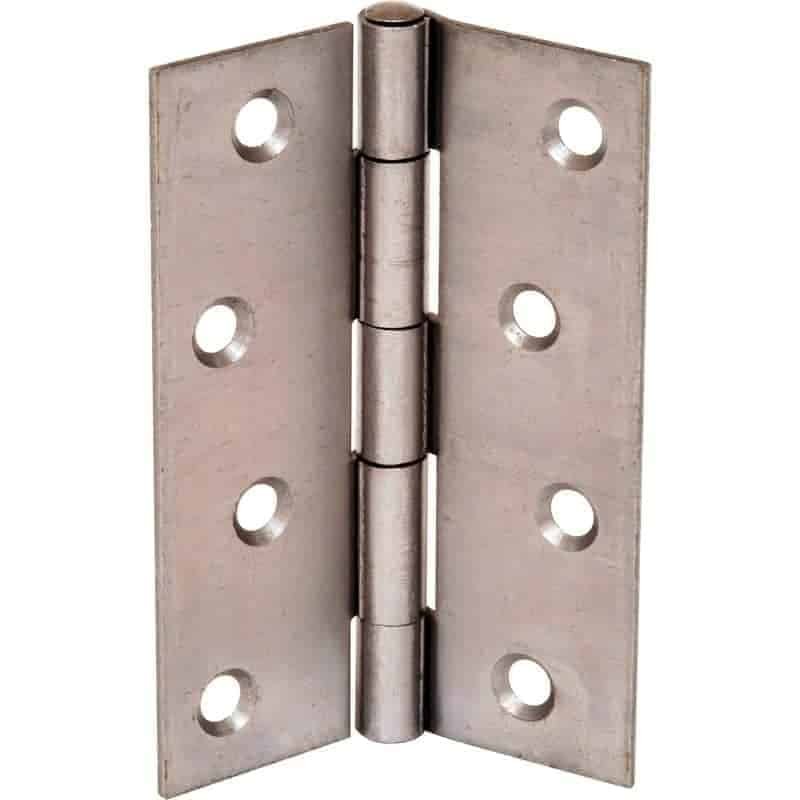
Let’s start with the most common type of hinge: butt hinges.
Butt hinges have a simple design, consisting of two plates connected by an interlocking barrel and a pin in the middle.
You’ve undoubtedly seen these hinges as they’re incredibly versatile and are used in many jobs, from hanging doors, windows, cabinets and beyond.
Butt hinges are used for lightweight and heavy-duty materials, which is why you generally find this hinge on standard doors. You can purchase them in a wide variety of metals to match your other hardware (handles, latches etc.), and they’re very inexpensive.
When installing butt hinges, each plate of the hinge must be recessed into the surface it will sit. This means chiselling the door and frame to allow the open/closing action to work properly. Whilst it’s not a huge job, it requires some skill.
This hinge is the one to go for if you’re looking for a simple hinge without any extras.
Pro Tip: You can purchase butt hinges in various decorative designs, known as ‘Butterfly Hinges’.
2. Rising Hinges
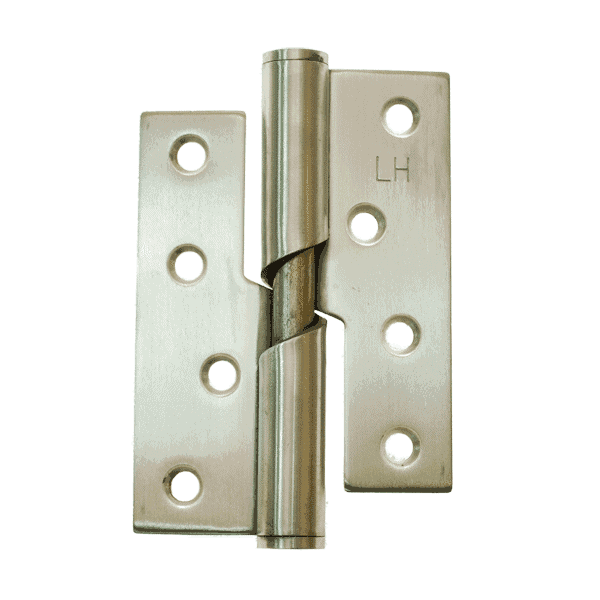
Butt hinges are great, but sometimes you need a bit more from a hinge. A rising hinge looks very similar to a butt hinge, but it’s designed so that one side of the hinge rises as the door opens, thus lifting the door.
These hinges are commonly used when the door would otherwise hit floor coverings. For example, doors that open over thick carpet.
Similarly to butt hinges, rising hinges must also be recessed into the frame and door. Depending on the door’s opening, you can purchase them in either ‘left-handed’ or ‘right-handed’ openings.
Once fitted, rising hinges can be separated, so you can lift the door from the frame without removing the hinge. This feature makes future door replacement and repairs much easier.
3. Security Hinges
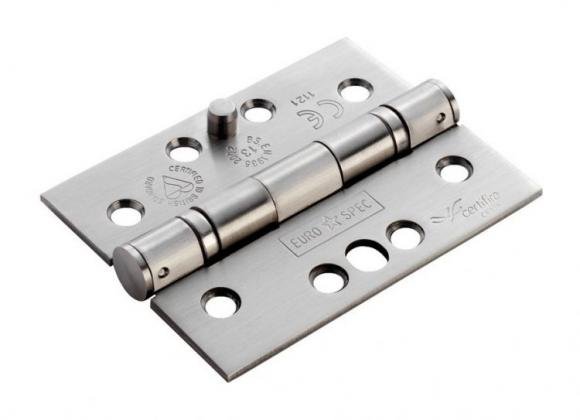
It’s important to use security hinges when fitting hinges on external doors. These are essentially butt hinges, but the pin between the two plates cannot be removed.
If the pin of a standard butt hinge is removed, the hinge splits into two halves, allowing burglars to pry open the door. There’s no point fitting an enhanced security lock to your door if your hinges aren’t up to the job! You need both.
Pro Tip: When using any hinge on an external door (security or not), buy corrosion-resistant hinges to prevent rusting.
4. Spring Hinges
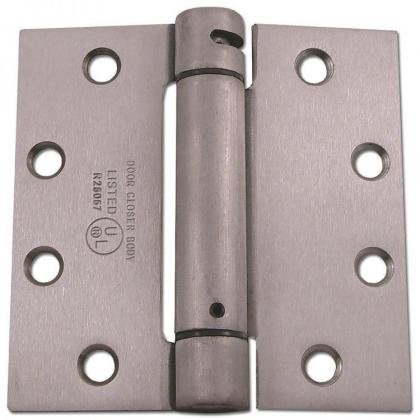
Another variety of the butt hinge family is a spring-loaded hinge.
As its name suggests, it’s fitted with a hidden internal spring, allowing doors to self-close automatically.
Spring hinges are used when you want the door to close automatically. For example, pets moving between rooms or reducing noise and heat loss from room to room.
The springs are usually adjustable, allowing you to alter how quickly the door shuts back into its original position.
5. Flush Hinges
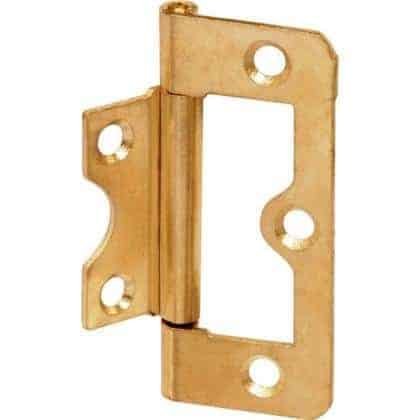
Sometimes, you can’t recess a hinge because the material is too thick to chisel. In these cases, flush hinges are used. Their unique design allows them to close into one another (as opposed to against one another), making a flush close without needing to chisel a recess.
Since there’s no chiselling involved, it makes them incredibly easy to fit as they screw straight onto the door or frame.
However, due to their thin construction, you can only use them on lightweight materials, so heavy doors are a definite no-no!
Flush hinges are often used for cabinetry, wardrobes or MDF doors, as Charlie demonstrates in the video below:

6. Parliament Hinges
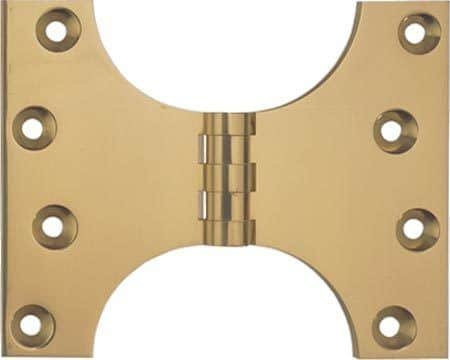
Some doors cannot fully open because the door hits against the frame, skirting, or other objects. This is where parliament hinges come in handy.
Parliament hinges are almost the same as butt hinges. However, they have one major difference — they’re wide and protrude from the frame. This design allows doors to extend fully and open flat against the wall.
You’ll often see these hinges on patio doors because they remove wasted space behind a partially open door. The only downside is their appearance. I.e. they protrude outwards.
7. Double Action Hinges
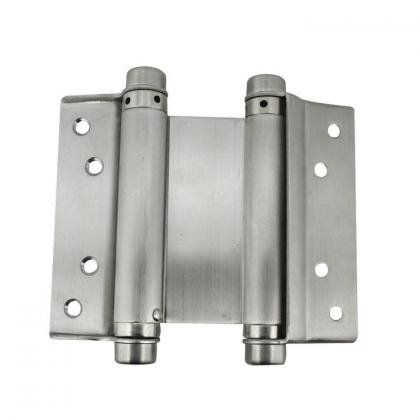
Normally, a hinge only opens one way, either inwards or outwards. But, with a double-action hinge, you get both. This feature makes them great for kitchen doors where people constantly move in and out.
Visually, a double-action hinge looks like a folded hinge. One side mounts to the frame and the other to the door, with the folding action in between.
An adjustable tension rod lets you change how quickly the door swings back to its closed position.
8. T-Hinges
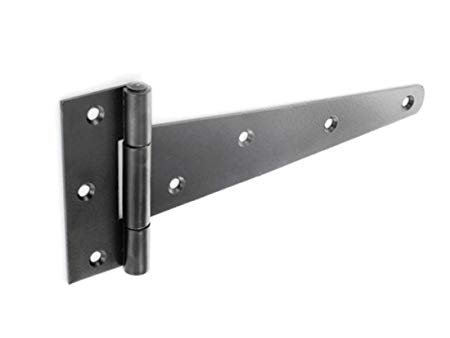
T-hinges are shaped like a ’T’ but turned on their side. Not only do these hinges have a visual charm, but they’re also ideal for wide doors and gates.
These hinges come in various lengths, including 600mm and beyond. These long lengths allow t-hinges to reach far across large gates and doors, allowing them to be properly braced without any sagging. Aside from their practical abilities, they’re also favoured in cottage-style properties and barns for their quirky rustic charm.
For an in-depth installation guide on these, check out this article.
Pro Tip: According to The Suffolk Latch Company, ensure it covers just over half the width of your door when selecting a T-Hinge.
9. Continuous Hinges
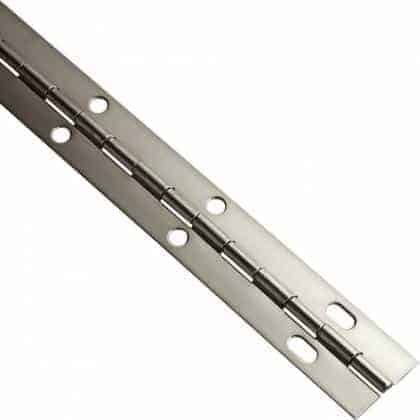
Unlike the hinges above, which are mounted in pairs, a continuous hinge runs the entire door length. Because of its long length, the door’s weight is evenly distributed throughout the hinge. This feature makes continuous hinges very robust and ideal for doors receiving lots of wear and tear.
Some call this hinge a ‘piano hinge’, as it was originally used on hinged lids of grand pianos.
10. Concealed Hinges
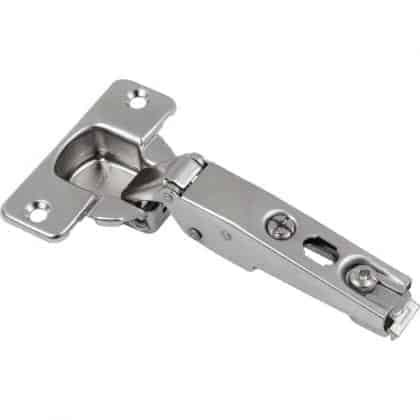
Last but not least is the concealed hinge, which cannot be seen from the outside. Furthermore, these hinges are adjustable after installation, making them ideal for kitchen cabinets and wardrobes.
So, if your door isn’t hanging perfectly, you don’t need to remove and re-install it. Simply turning a few screws moves the hinge up, down, forward and backwards.
To fit this hinge, you must drill a hole into the back of the door where the hinge will be recessed. Each concealed hinge is slightly different depending on the brand and type. In the video below, Charlie explains how to fit concealed hinges in cabinets.

Final Thoughts
So that’s the top 10 hinges covered! Who knew each hinge could be so different from the next?
To learn more about hinges, check out our guide to the various types of uPVC door hinges. Happy hinging!

